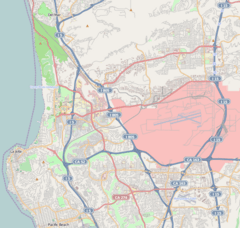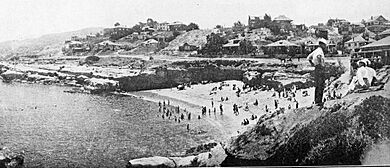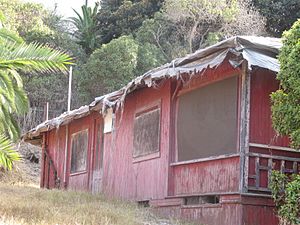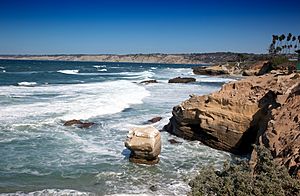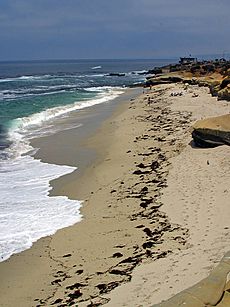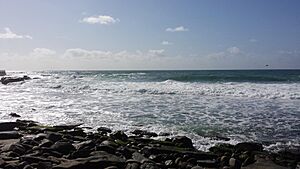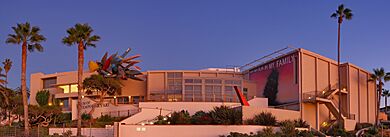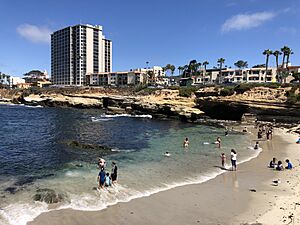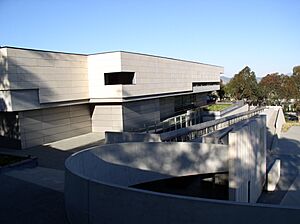La Jolla facts for kids
Quick facts for kids
La Jolla, San Diego
|
|
|---|---|
 |
|
| Nickname(s):
"The Jewel"
|
|
| Country | United States |
| State | California |
| County | San Diego |
| City | San Diego |
| Founded: | 1850 |
| Population
(2010)
|
|
| • Total | 46,781 |
| Time zone | UTC−08:00 (UTC--08:00) |
| • Summer (DST) | UTC−07:00 (UTC--07:00) |
| ZIP Code |
92037-92039, 92092, 92093
|
| Area codes | 858, 619 |
La Jolla (pronounced "la HOY-uh") is a beautiful seaside town in San Diego, California. It has 7 miles (11 km) of coastline along the Pacific Ocean. About 46,781 people lived here in 2010. It has a mild climate, with an average temperature of 70.5°F (21.4°C).
La Jolla is surrounded by ocean cliffs and beaches on three sides. It is located 12 miles (19 km) north of downtown San Diego. The town's border starts at Pacific Beach to the south. It goes north along the ocean to include Torrey Pines State Natural Reserve.
La Jolla is home to many schools and businesses. These include places for lodging, dining, shopping, and scientific research. The University of California, San Diego (UCSD) is in La Jolla. So are Birch Aquarium, Scripps Institution of Oceanography, Scripps Research, and the Salk Institute for Biological Studies.
Contents
History of La Jolla
What's in a Name?
The local Native Americans, called the Kumeyaay, named this place "mat kulaaxuuy." This means "land of holes." These "holes" might have been sea caves along the bluffs.
Spanish settlers later wrote the name as "La Jolla." Some people think it comes from the Spanish phrase "la joya," meaning "the jewel." This idea led to La Jolla's nickname, "The Jewel." Another idea is that it comes from "La Hoya," meaning a geographic hollow.
Early Days of the Town
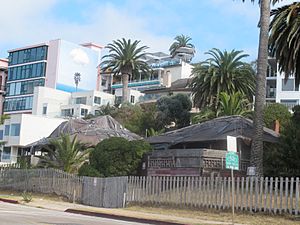
When California became a state in 1850, La Jolla became part of the city of San Diego. In the 1880s, more people started to develop the area.
In the 1890s, a railway was built. It connected La Jolla to the rest of San Diego. La Jolla became a popular resort area. The railway built a bath house and a dance hall to attract visitors. People stayed in small cottages or in a temporary "tent city" during the summer.
Two cottages built in 1894, called "Red Roost" and "Red Rest," are the oldest buildings still in their original spot. They have been empty since the 1980s. In November 2020, the Red Rest was mostly destroyed by a fire.
By 1900, La Jolla had 100 buildings and 350 residents. The first library was built in 1898. A volunteer fire department started in 1907.
La Jolla Elementary School opened in 1896. The Bishop's School opened in 1909. La Jolla High School was established in 1922.
Ellen Browning Scripps' Gifts
In 1896, a rich journalist named Ellen Browning Scripps moved to La Jolla. She spent the last 35 years of her life there. She used her wealth to help La Jolla. She paid for many of the town's famous buildings. Many of these buildings are now historic landmarks.
Her projects included the La Jolla Woman's Club (1914) and the La Jolla Recreational Center (1915). She also helped build early parts of The Bishop's School. Her own home, built in 1915, is now the Museum of Contemporary Art San Diego.
Ellen Browning Scripps also helped start Scripps Memorial Hospital in 1924. She founded the Scripps Metabolic Clinic (now Scripps Research) and the Children's Pool.
Scripps Institution of Oceanography
The Scripps Institution of Oceanography is one of the oldest ocean research centers in the country. It started in 1903. It was founded by William Emerson Ritter with money from Ellen Browning Scripps and her brother.
At first, it was in a boathouse in Coronado. In 1905, they bought 170 acres (69 ha) in La Jolla. The first lab buildings opened there in 1907. It became part of the University of California in 1912. This institution later helped create the University of California, San Diego.
University of California, San Diego (UCSD)
Local leaders wanted a UC campus in San Diego after World War II. The Scripps Institution of Oceanography was doing important research. Local aerospace companies also wanted trained scientists.
The state approved the idea in 1955. The university officially started in 1960. It was briefly called "University of California, La Jolla." But the name changed to "University of California, San Diego" before it opened.
UCSD was designed with a "college" system. The first college, Revelle College, opened in 1965. It was named after Roger Revelle, who helped create the university. A medical school started in 1968. The unique Geisel Library opened in 1970. UCSD is a major employer and a top research university.
Mount Soledad Cross Memorial
Mount Soledad is an 822-foot (251 m) tall hill in La Jolla. It is one of the highest points in San Diego. A large Christian cross was placed at the top in 1913. It was replaced in 1954 with a 29-foot (9 m) tall cross.
Over the years, the cross became part of a war memorial. It was renamed the "Mount Soledad Veterans War Memorial." For a long time, there were legal debates about having a religious symbol on public land.
In 2015, a group called the Mt. Soledad Memorial Association bought the land under the cross. This meant the cross was no longer on government land. In 2016, a court ruled that the legal case was over.
Arts and Culture
La Jolla became an art colony in 1894. Anna Held started the Green Dragon Colony, a group of rustic cottages.
The La Jolla Playhouse was founded in 1947 by famous actors like Gregory Peck. It closed in 1959 but reopened in 1983 at the University of California campus. It now has three theaters.
The Museum of Contemporary Art San Diego started in 1941. It is in the former home of Ellen Browning Scripps. The museum has many American and European artworks from after 1950.
The La Jolla Music Society began in 1941. It used to hold concerts at La Jolla High School. Since 2019, it has its own home, the Conrad Prebys Performing Arts Center. This center hosts many world-class performances.
Geography and Nature
La Jolla's Location
La Jolla's border starts at Pacific Beach to the south. It goes north along the Pacific Ocean to include Torrey Pines State Natural Reserve. La Jolla includes neighborhoods like Bird Rock, Windansea Beach, the Village of La Jolla, La Jolla Shores, and Mount Soledad.
The City of San Diego says La Jolla's eastern border is Gilman Drive and Interstate 5. Its northern border is UCSD.
The United States Postal Service gives La Jolla its own ZIP Code, 92037. This makes it seem like a separate city, but it is part of San Diego.
Amazing Wildlife
La Jolla's ocean waters are full of marine wildlife. You can see gray, humpback, and blue whales migrating. There are also harbor porpoises and many types of dolphins. California sea lions and harbor seals often rest on the rocks.
The area has many fish, like garibaldi and leopard sharks. Sometimes, great white sharks come closer to shore in winter. They hunt seals around the kelp forest.
Many sea animals live in the large offshore kelp forest. Scuba divers love to explore these underwater forests. They are home to sea urchins, abalone, sea stars, and giant octopus. Green sea turtles and many sea birds also live here.
Land and Climate
La Jolla has sandy beaches and rocky shorelines. It can sometimes have floods and ocean storms.
Mount Soledad is an 823-foot (251 m) mountain. It has many narrow roads and homes with ocean views. It is home to the Mount Soledad Cross memorial.
The coastline has cliffs and beaches. It is a home for many wild seals. There are many beaches you can reach from the cliffs.
| Climate data for La Jolla, San Diego | |||||||||||||
|---|---|---|---|---|---|---|---|---|---|---|---|---|---|
| Month | Jan | Feb | Mar | Apr | May | Jun | Jul | Aug | Sep | Oct | Nov | Dec | Year |
| Record high °F (°C) | 89 (32) |
91 (33) |
93 (34) |
99 (37) |
101 (38) |
103 (39) |
108 (42) |
104 (40) |
111 (44) |
107 (42) |
100 (38) |
88 (31) |
111 (44) |
| Mean daily maximum °F (°C) | 66 (19) |
67 (19) |
68 (20) |
69 (21) |
70 (21) |
73 (23) |
77 (25) |
79 (26) |
78 (26) |
75 (24) |
71 (22) |
67 (19) |
72 (22) |
| Mean daily minimum °F (°C) | 47 (8) |
49 (9) |
51 (11) |
54 (12) |
58 (14) |
61 (16) |
64 (18) |
66 (19) |
64 (18) |
59 (15) |
51 (11) |
47 (8) |
56 (13) |
| Record low °F (°C) | 29 (−2) |
36 (2) |
38 (3) |
40 (4) |
45 (7) |
50 (10) |
55 (13) |
57 (14) |
51 (11) |
43 (6) |
36 (2) |
34 (1) |
29 (−2) |
| Average precipitation inches (mm) | 2.73 (69) |
2.44 (62) |
2.66 (68) |
0.93 (24) |
0.28 (7.1) |
0.09 (2.3) |
0.03 (0.76) |
0.10 (2.5) |
0.27 (6.9) |
0.48 (12) |
1.23 (31) |
1.53 (39) |
12.77 (324) |
People and Homes
According to the 2010 census, most people in La Jolla are White (82.5%). There are also many Asian (11.2%) and Latino (7.2%) residents.
La Jolla has some of the most expensive homes in the country. In 2009, the average price for a four-bedroom home was about $2.125 million.
Neighborhoods to Explore
La Jolla has many different neighborhoods:
- La Jolla Farms — This area is west of UCSD. It has the Torrey Pines Gliderport and the Salk Institute for Biological Studies.
- La Jolla Shores — This is a residential area along La Jolla Shores Beach. It also has the Scripps Institution of Oceanography campus.
- The Village — This is the "downtown" area of La Jolla. It has most of the shops and restaurants.
- Beach-Barber Tract — This coastal area goes from Windansea Beach to The Village.
- Lower Hermosa — A coastal strip south of Beach-Barber Tract.
- Bird Rock — This is the southern coastal part of La Jolla. It's known for its shops, restaurants, and surfing spots.
- Muirlands — A large area on the western side of Mount Soledad.
- La Jolla Village — This is in northeast La Jolla, near I-5 and UCSD. It has the La Jolla Village Square shopping mall.
Community Groups
The La Jolla Community Planning Association helps advise the city council on plans for the area. The La Jolla Town Council represents local businesses and residents. Other groups like the Bird Rock Community Council and La Jolla Shores Association serve specific neighborhoods.
Some groups, like Independent La Jolla, want La Jolla to become its own city. There are also service clubs like Kiwanis and Rotary.
La Jolla is also home to InspirED, a company that helps schools support students' mental health.
Fun Things to Do
La Jolla is home to Torrey Pines Golf Course. This course hosts a big PGA Tour event called the Farmers Insurance Open every year. It also hosted the U.S. Open in 2008 and 2021.
Torrey Pines Gliderport is a popular spot where people fly and watch gliders.
Downtown La Jolla has many jewelry stores, boutiques, and nice restaurants. The Museum of Contemporary Art has a great collection of modern art.
Since 2011, the La Jolla Community Foundation has added murals by different artists around town.
Beaches and ocean spots include Windansea Beach, La Jolla Shores, La Jolla Cove, and Children's Pool Beach. La Jolla Cove is very popular for snorkeling, swimming, and seeing wildlife like seals. The La Jolla Concours d'Elegance car show happens here every year.
Here are some popular beaches and coastal spots:
- Torrey Pines State Natural Reserve
- Black's Beach
- Scripps Beach (near Scripps Institution of Oceanography)
- La Jolla Shores
- La Jolla Beach & Tennis Club
- La Jolla Cove
- Boomers Beach
- Shell Beach
- Children's Pool Beach
- Wipeout Beach
- Horseshoes
- Marine Street
- Windansea Beach
- Bird Rock
Getting Around
The San Diego Trolley light rail system has four stops in La Jolla:
- Nobel Drive (serves La Jolla Village Square)
- VA Medical Center (serves the Veteran Affairs hospital)
- UC San Diego Central Campus (in the middle of UCSD)
- UC San Diego Health La Jolla (near hospitals and medical facilities)
These stations opened on November 21, 2021. They connect La Jolla to other parts of San Diego.
Education in La Jolla
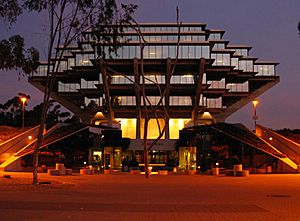
Colleges and Universities
The University of California San Diego (UCSD) is the main center for higher education in La Jolla. It includes Scripps Institution of Oceanography and the San Diego Supercomputer Center.
National University also has its main office in La Jolla. Many research institutes are near UCSD, such as Scripps Research Institute and the Salk Institute for Biological Studies.
Schools for Kids
La Jolla is part of the San Diego Unified School District. Public schools include La Jolla High School, La Jolla Elementary, Muirlands Middle School, Torrey Pines Elementary, and Bird Rock Elementary. Preuss School is a public charter school.
Private schools include The Bishop's School, The Children's School, Stella Maris Academy, The Gillispie School, and the Evans School. La Jolla Country Day School is in the nearby community of University City.
Places of Worship
Christian Churches:
- All Hallows Catholic Church
- Assembly of God
- Christian Science Church
- Congregational Church
- Barabbas Road Church
- First Baptist Church
- La Jolla Christian Fellowship
- La Jolla Lutheran Church
- La Jolla Presbyterian Church
- La Jolla Religious Society of Friends
- La Jolla United Methodist Church
- Mary, Star of the Sea Catholic church
- Prince Chapel by the Sea (African Methodist Episcopal Church)
- St. James by-the-Sea Episcopal
- St. John Church of God in Christ
- Torrey Pines Christian Church
- The Church Of Jesus Christ of Latter-day Saints San Diego California Temple
- University Lutheran Church
Jewish Synagogues:
- Congregation Beth El
- Congregation Adat Yeshurun
- Chabad Jewish Center of La Jolla
La Jolla in Books and Movies
- La Jolla (called "Esmerelda") is the setting for Raymond Chandler's book, Playback (1958). Chandler lived in La Jolla.
- La Jolla was home to the comic book publisher WildStorm Productions from 1993 to 2012.
- La Jolla is mentioned in Beach Boys' 1963 song "Surfin' U.S.A." and in Wilbur Soot's 2020 song "La Jolla."
Movies Filmed in La Jolla
- Lab scenes for the movie The Cell (2000) were filmed at The Neurosciences Institute in La Jolla.
- La Jolla is one of the places shown in the movie Traffic (2000).
- Scenes for the movie The Samuel Project (2018) were filmed in La Jolla.
TV Shows Set in La Jolla
- La Jolla was the setting for the 2011 season of The Real World: San Diego on MTV.
- The Netflix show Grace and Frankie is set in La Jolla.
- Disney+'s Big Shot also takes place in La Jolla.
Famous People from La Jolla
Many famous people have lived in La Jolla. These include scientists, business leaders, artists, writers, and performers.
See also
 In Spanish: La Jolla para niños
In Spanish: La Jolla para niños


